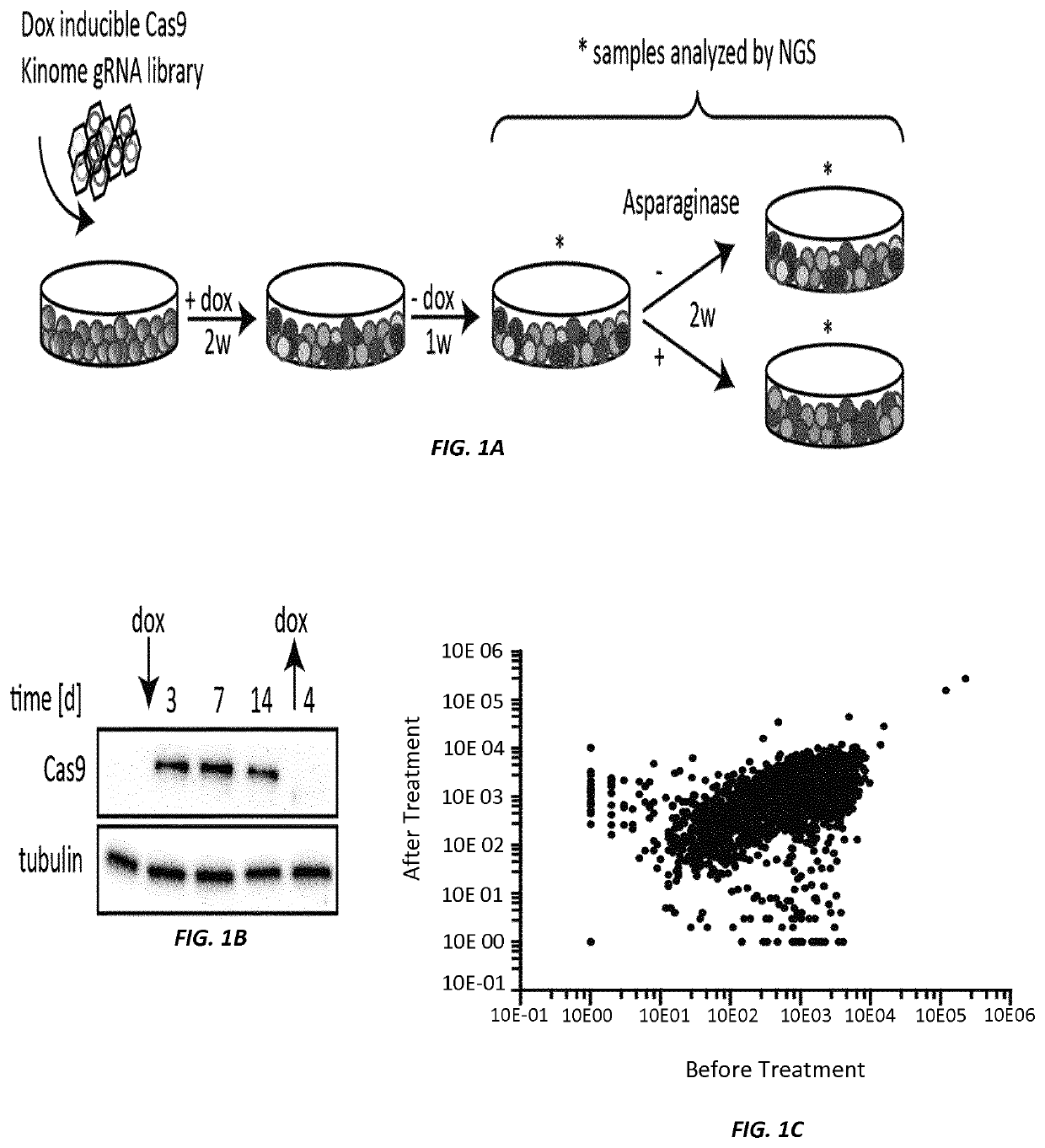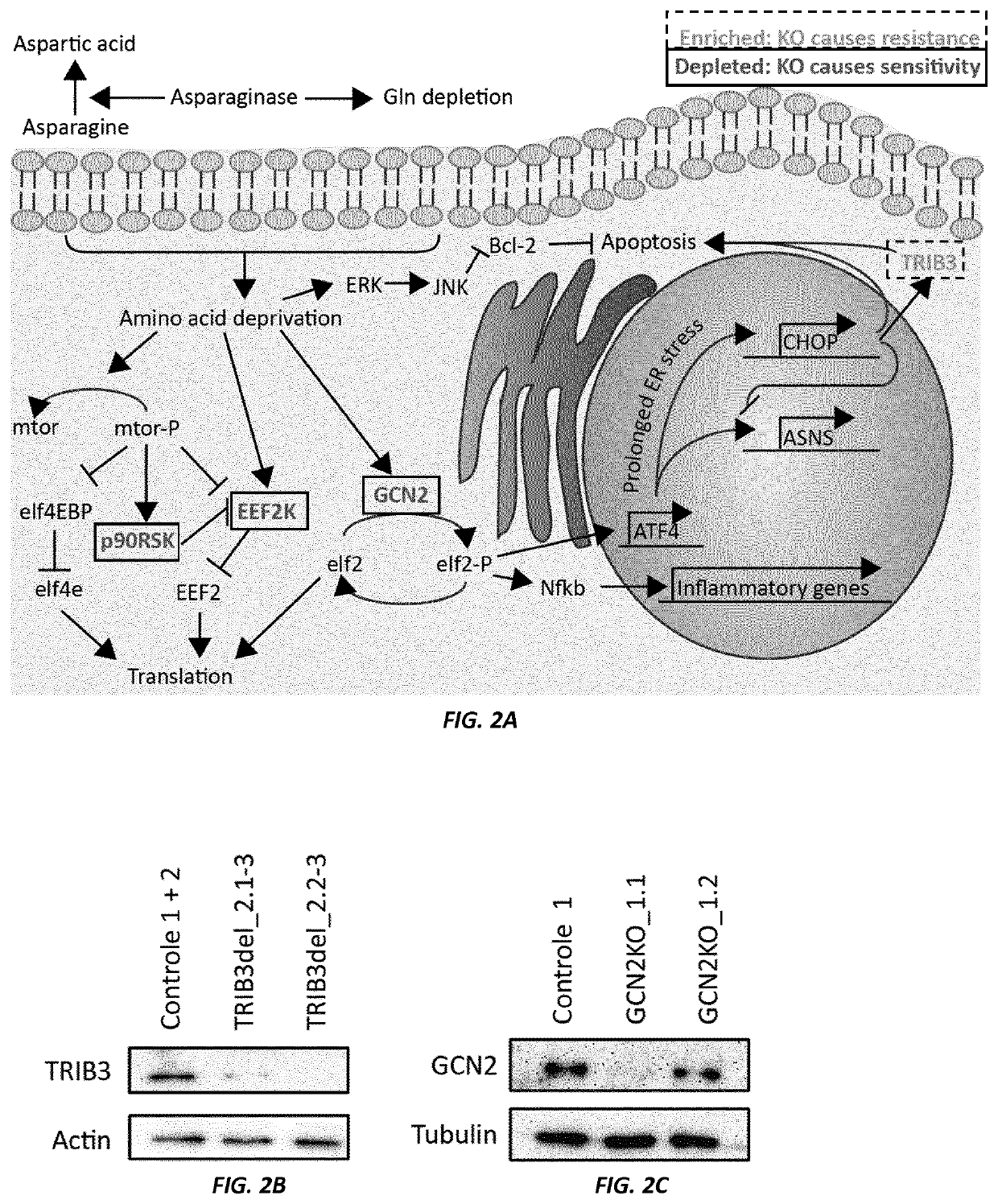Synergistic Combinations of Amino Acid Depletion Agent Sensitizers (AADAS) and Amino Acid Depletion Agents (AADA), and Therapeutic Methods of Use Thereof
a technology of amino acid depletion agent, which is applied in the field of cancer treatment, can solve the problems of increasing the risk of relapse, enhancing the chance of relapse, and silent inactivation of the drug
- Summary
- Abstract
- Description
- Claims
- Application Information
AI Technical Summary
Benefits of technology
Problems solved by technology
Method used
Image
Examples
example 1
s9 Based Kinome Screen Identifies BTK as an Important Determinant of Asparaginase Treatment Response in Acute Lymphoblastic Leukemia (ALL)
[0209]Unless otherwise specified below, the in vitro studies were conducted using native E. coli ASNase (NCBI WP_000394140.1), and in vivo studies were conducted using ONCASPAR®. Moreover, all references to commercial product specifications should be interpreted to mean as understood by the skilled artisan as of the time of the filing of this application.
[0210]Briefly, a CRISPR / Cas9-based kinome screen (outlined in FIG. 1A) was conducted to identify genes whose deletion would have an impact on the ALL cells' sensitivity to amino acid depletion by ASNase. Nalm6 pre-B ALL cells were transduced with a lentivirus encoding a doxycycline inducible Cas9. Subsequently, a gRNA library targeting 506 kinases was introduced by lentiviral transduction with an average of one gRNA per cell. Each individual kinase in the library was represented by 10 gRNAs. After...
example 2
sponse is Affected by Kinases Regulating the ER Stress Response Pathway
[0212]A series of experiments was conducted to begin to understand the mechanisms involved in the observed gene-deletion-mediated sensitization or resistance to amino acid starvation stress induced by ASNase.
[0213]FIG. 2A presents a schematic overview of the amino acid response pathway. Kinases representing gRNAs enriched in the screen are shown in blue, and kinases representing gRNAs that are selectively lost (dropouts) are shown in purple. Targeted knockout experiments were used to validate these results in independent experiments. As indicated by the Western Blot data shown in FIG. 2B, the TRIB3 gene was effectively disrupted by CRISPR / Cas9 mediated introduction of frame shift mutations / deletions in a pool of Nalm6 cells. In another pool of Nalm6 cells, the GCN2 gene was similarly disrupted by CRISPR / Cas9 mediated introduction of frame shift mutations / deletions (FIG. 2C). Nalm6 wt and TRB3 knockout cells (pool...
example 3
Deletion or Pharmacological Inhibition of BTK Sensitizes Nalm6 Cells to ASNase Treatment
[0215]A series of experiments was conducted to study the impact of deletion or pharmacological inhibition of Bruton's Tyrosine Kinase (BTK) on the response of cells to ASNase treatment.
[0216]BTK Deletion. FIG. 3A presents a schematic overview depicting the (pre-) B cell receptor pathway. Initially, the BTK gene was disrupted by CRISPR / Cas9 mediated introduction of frame shift mutations / deletions in Nalm6 cells and single cell clones were evaluated for BTK expression using Western blot (FIG. 3C). Nalm6 wt Clones and BTK knockout clones were then either treated with 1 or 5 IU / ml ASNase or left untreated for 1 week before the SubG1 (apoptotic) fraction was measured by Flow cytometry. (FIGS. 3D & 3E) The same cells were also analyzed for the presence of apoptotic cells by Hoechst staining (FIGS. 3G & 3H). Asterisks indicate a significant difference: * p<0.05, ** p<0.01, *** p<0.001.
[0217]BTK inhibiti...
PUM
| Property | Measurement | Unit |
|---|---|---|
| amino acid stress responses | aaaaa | aaaaa |
| stress | aaaaa | aaaaa |
| size | aaaaa | aaaaa |
Abstract
Description
Claims
Application Information
 Login to View More
Login to View More - R&D
- Intellectual Property
- Life Sciences
- Materials
- Tech Scout
- Unparalleled Data Quality
- Higher Quality Content
- 60% Fewer Hallucinations
Browse by: Latest US Patents, China's latest patents, Technical Efficacy Thesaurus, Application Domain, Technology Topic, Popular Technical Reports.
© 2025 PatSnap. All rights reserved.Legal|Privacy policy|Modern Slavery Act Transparency Statement|Sitemap|About US| Contact US: help@patsnap.com



